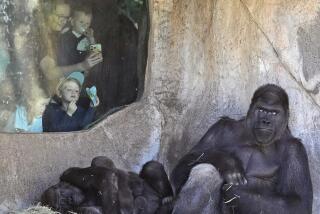They’re Just Wild and Crazy Animals--or Are They? : Zoos: Animal-rights group contends that mental illness is rampant among confined animals. But many experts disagree with their analysis.
- Share via
LONDON — A bulimic gorilla, a psychotic baboon, a self-mutilating bear. Not the sorts of furry creatures people hope to see at the zoo.
But according to a survey conducted by Britain’s Born Free Foundation, mental illness is rampant among zoo animals.
The foundation, a charity that monitors animals in captivity, did not calculate the numbers of animals affected compared with the total number of animals monitored, which concerns skeptics.
But in a telephone interview, the researchers said their examples represent a global problem.
“The most important thing was the same species displayed the same abnormal behavior in zoos worldwide,” said William Travers, the director of the study.
“Our evidence confirms that deprived of their natural environment, social structures and outlets for many of the skills for which they have naturally evolved, animals exhibit abnormal behavior.”
Most experts agree that caged animals pick up peculiar habits, but not all consider this behavior a sign of insanity.
The borderline between sanity and mental illness is fuzzy among humans, and even blurrier among non-humans. Scientists do not know how or even if animals think. If they do, what’s normal?
“If you can define a behavior as not productive or damaging to the animal, like self-mutilation, or if it does not occur in the wild, then I would say that’s madness,” said Roger Mugford, an animal psychologist who worked on the survey.
But Barry Keverne, the director of Animal Behavior at Cambridge University, said “mental illness” is a term he wouldn’t use.
The most common behavior among caged animals is called stereotypy, repeating an activity over and over, such as obsessive pacing or head bobbing.
“It’s a motor activity,” said Keverne. “You don’t know that it is mental illness, and you don’t know why they are doing it.”
“No doubt you see it in captive animals and occasionally in horses in fields where they have restricted territory,” he said. “But it may be a way of alleviating stress and making them feel better.”
Between 1990 and 1992, researchers from the Born Free Foundation visited 100 zoos in Europe and the United States and recorded animal behavior on video.
The long list of allegedly disturbed animals includes a bulimic gorilla in Barcelona, bulimic chimps in the Sacramento Zoo, a bear in Rome that pulls its hair out, tongue-twirling giraffes in Japan and a baboon in Cyprus that supposedly cannot stop doing back flips. Travers considers the baboon psychotic.
The investigators tallied traits supposedly suggestive of mental illness, but did not calculate the percentage of animals afflicted. Some investigators question the validity of the conclusions because they are not based on a scientific analysis.
Despite this, Travers insists the situation is rampant.
“The important thing is that most of these behaviors have a germ of normality in them, but in captivity become obsessive,” he said. “That’s when we start to be concerned.”
Peter Olney, director of the Federation of Zoos in London, said the survey exaggerates the extent of the problem.
“We in the zoo community are aware of this and of course we are equally concerned to improve the situation,” said Olney, whose group coordinates breeding programs and educational activities for 52 British zoos.
Mugford, who provides one-on-one therapy for disturbed animals, said it is far simpler to prevent the development of illness than to treat it.
Olney and other authorities suggest trying to make zoos mimic the natural habitat as much as possible.
Marian Dawkins, a scientist at the Animal Behavior Department at Oxford University, said forcing animals to forage for food, the way they do in the wild, seems to reduce obsessive pacing or head bobbing.
Other techniques, said Travers, include random feeding rather than giving meals at the same time every day, and keeping animals in groups rather than alone or in pairs.
More to Read
Sign up for Essential California
The most important California stories and recommendations in your inbox every morning.
You may occasionally receive promotional content from the Los Angeles Times.













